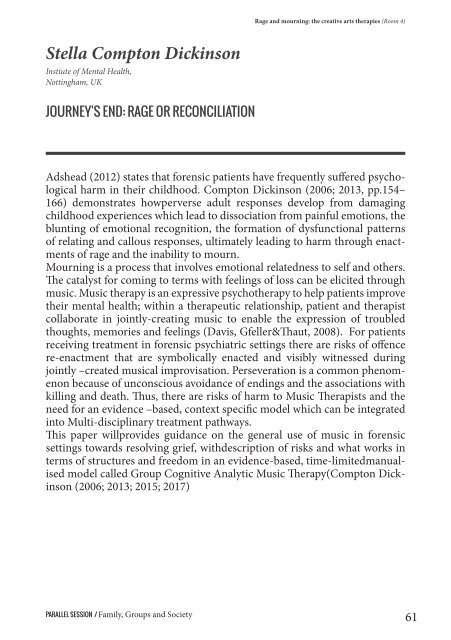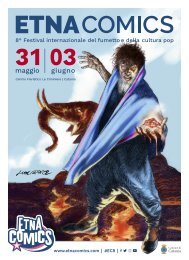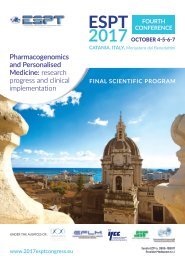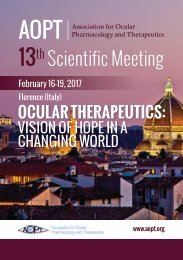pieghevole
You also want an ePaper? Increase the reach of your titles
YUMPU automatically turns print PDFs into web optimized ePapers that Google loves.
Rage and mourning: the creative arts therapies (Room 4)<br />
Stella Compton Dickinson<br />
Instiute of Mental Health,<br />
Nottingham, UK<br />
JOURNEY'S END: RAGE OR RECONCILIATION<br />
Adshead (2012) states that forensic patients have frequently suffered psychological<br />
harm in their childhood. Compton Dickinson (2006; 2013, pp.154–<br />
166) demonstrates howperverse adult responses develop from damaging<br />
childhood experiences which lead to dissociation from painful emotions, the<br />
blunting of emotional recognition, the formation of dysfunctional patterns<br />
of relating and callous responses, ultimately leading to harm through enactments<br />
of rage and the inability to mourn.<br />
Mourning is a process that involves emotional relatedness to self and others.<br />
The catalyst for coming to terms with feelings of loss can be elicited through<br />
music. Music therapy is an expressive psychotherapy to help patients improve<br />
their mental health; within a therapeutic relationship, patient and therapist<br />
collaborate in jointly-creating music to enable the expression of troubled<br />
thoughts, memories and feelings (Davis, Gfeller&Thaut, 2008). For patients<br />
receiving treatment in forensic psychiatric settings there are risks of offence<br />
re-enactment that are symbolically enacted and visibly witnessed during<br />
jointly –created musical improvisation. Perseveration is a common phenomenon<br />
because of unconscious avoidance of endings and the associations with<br />
killing and death. Thus, there are risks of harm to Music Therapists and the<br />
need for an evidence –based, context specific model which can be integrated<br />
into Multi-disciplinary treatment pathways.<br />
This paper willprovides guidance on the general use of music in forensic<br />
settings towards resolving grief, withdescription of risks and what works in<br />
terms of structures and freedom in an evidence-based, time-limitedmanualised<br />
model called Group Cognitive Analytic Music Therapy(Compton Dickinson<br />
(2006; 2013; 2015; 2017)<br />
PARALLEL SESSION / Family, Groups and Society<br />
61











